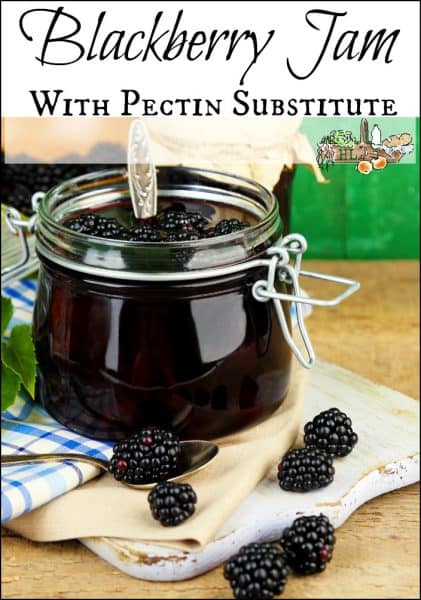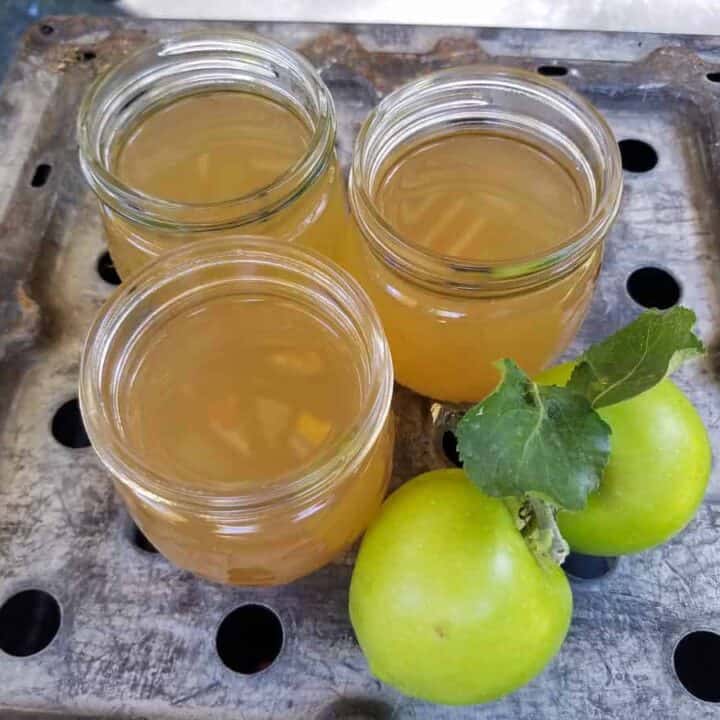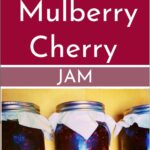Learn to make natural pectin substitute for jams and jellies by dehydrating or freeze drying high-pectin fruits and preparing them for use in canning. In this article, you will learn to make natural pectin powder from apples, but there are other fruits you can use, as well as other methods. Let’s chat about all things DIY natural pectin!
What is Natural Pectin?
Pectin is a naturally occurring carbohydrate in a variety of fruits. Fruits like:
- Apple, including Crab Apples
- Quince
- Plums
- Cranberries
- Citrus peels, especially the pith
Basically, if a fruit is particularly firm, it probably has a high amount of pectin. Gooseberries and Jostaberries are good examples, which I also could have put on the list above.
Home canners use pectin to thicken homemade jams and jellies. It’s typical for jam makers to purchase pectin produced commercially.
Sometimes, though, you go to grab your pectin to thicken the jam that’s simmering on your stove but you’re out! Oh, no!
Now, you can set jam without pectin at all. This is especially simple if you’re making jam from an already high pectin fruit like apples and plums. However, with low pectin jams like strawberries and blueberries, adding pectin can create a quality, firm set, and save time!
Ways to Thicken Jams Without Pectin
As I said, you can thicken jam using the fruit’s natural sugars, as well as granulated sugar from the jam recipe, and a long cook time. As an example, Practical Self Reliance can teach you how to make plum jam without pectin.
Though corn starch isn’t recommended for canning recipes, you can use it to thicken jams you don’t intend to preserve by canning. Other products like agar, chia seeds, and even gelatin can be used to thicken jam recipes that aren’t going to be canned.
Are Pectin and Gelatin the Same Thing?
No, pectin and gelatin are two very different products. Pectin is a fibrous product that is made from fruits. Whereas, gelatin is derived from animal products of various kinds.
Though both are water soluble and can be used for thickening, the two products are different in make up.
Get Natural Pectin From Apples
Today, I’m sharing a simple method for making natural pectin from apples. However, you can follow these instructions for pears and quince. Possibly even plums, but I have yet to try them myself. If you end up making natural pectin from plums, please let me know how it goes and which kind of plums worked best!
For making natural pectin from apples and pears, always choose those that are the most firm. Although any apple or pear variety will work as a natural pectin, the dryer varieties work the quickest.
If you are using apples or pears you grow yourself, don’t stress about knowing the variety if you don’t. Just use whatever you have.
All quince varieties will work, so don’t worry about identifying the varieties.
The Best Way to Make Apple Pectin
There are several ways to make natural pectin from apples, and you can match the method to whatever your situation is at the moment.
If you already have a batch of jam on the stove and need a quick natural pectin substitute, you can grab some apples and your cheese grater or food processor.
–>>Learn to use raw, shredded apples as a pectin substitute for blackberry jam here<<–
If you have some time and are thinking ahead, you can make liquid apple pectin by following the instructions in the following article (scroll down about halfway down the article):
–>>5 Things to Do With Extra Apples<<–
My favorite way to make natural pectin from apples is to make powdered pectin from dehydrated or freeze dried apples. That method is the one I’ll detail here for you today.
Remember, you can use the same method for both pears and quince.
Make Powdered Natural Pectin Substitute for Jam & Jelly
The first step in making natural pectin powder is to dehydrated apple slices. For most of us, the easiest way to dry apples is to dehydrate them. Dehydrating fruit can be done via air-drying or in an oven, set to its lowest temperature.
Grow a Good Life can teach you both of those methods (air-drying and dehydrating in the oven) of Dehydrating Apples here.
To learn to use a dehydrator for drying apples, I suggest a good book.
Dehydrator Cookbook for Beginners
My friend Chris Dalziel has written yet another wonderful book; this time one on learning to dehydrate foods for storage. As the tagline of the book says, you can learn to dehydrate fruits, vegetables, meats, and more!
I actually own this book and have been using it this harvest season to keep up on all the food coming in from the gardens. Not only does Chris cover pretty much every fruit and veggie you can dehydrate, she also teaches readers how to save whole meals!
How to Dehydrate Apples for Natural Pectin Substitute
To help us learn to dehydrate apples, Chris has shared her recipe for them. We’ll take these dehydrated apple slices and powder them to make natural pectin powder.
This recipe is used with permission from Chris Dalziel’s book, Dehydrator Cookbook for Beginners, Copyright © 2022 by Rockbridge Press, Oakland, California.

How to Dehydrate Apples for Natural Pectin Substitute
Ingredients
- Firm Unblemished Apples*
Instructions
To Prepare
- Wash the apples in cold water with a squirt of dish soap and vinegar. Soak them briefly to remove grime and pesticide residues, then rinse and dry.
- Peeling the apples is optional (much of the nutrition in apples is close to the peel). Core the apples and cut them into 1/4-inch slices.
- Soak the slices in ascorbic acid solution for 1 minute, the drain them.
- Arrange the slices in a single layer on the dehydrator trays.
To Dehydrate
- Dehydrate at 135F for 4 hours. Reduce the temperature to 125F and continue drying for 4 to 8 hours.
- When dried, the apples should be leathery and crisp, with no spongy areas in the middle.
- Condition the apples before storing.
To Store
- Wrap the slices in a paper towel before sealing in a Mylar bag, to prevent them from piercing the bag in storage. Dried apples stored in vacuum-sealed glass jars, or Mylar bags with oxygen absorbers, will keep for up to 5 years.
Notes
To learn to make apple pectin from these dehydrated apples, please see the post.
Blend Dehydrated Apples for Natural Pectin Substitute
You can use pretty much any blender to make pectin powder from dehydrated apples. The more power the motor has and the sharper the blades are, the finer the resulting powder will be.
Instructions:
- Place at least one cup of dried apples into the blender body. You may blend more apples, if you’d like to make more pectin at one time. However, don’t blend more than 3 cups per batch to prevent the powder from overheating as it blends.
- Blend on high for 20-30 seconds. Shake down the contents. Repeat.
- Pulse to break up any large particles, letting the powder rest for a few seconds to let it cool down between blendings.
- Repeat the process until the powder is to your liking.
- Place in an airtight container and store in a cool, dark place.
You’ll end up with between 1/4 and 1/2 powder ratio to dehydrated apple slices.
The Difference Between Dehydrated and Freeze Dried Apples for Pectin Powder
Dehydrated apples slices will work very nicely as a pectin substitute. They will most likely end up a light caramel color once blended and perhaps be a bit sticky (they should never be wet, though).
My Vitamix blender can get the dehydrated apples slices powdered pretty finely. My Ninja blender does a decent job, but I have slightly larger bits of apple still in my pectin powder. It doesn’t matter much to me because the applet bits are effective as pectin, as well as tasty.
If you don’t like the larger bits, remove them with a fine mesh sieve and toss them into fruit salad.
Freeze dried apple slices will also work great but will blend down to a finer powder than dehydrated apples. The color will be lighter and you’ll probably end up using a bit less of the freeze dried powder than the dehydrated, but the difference in volume will be negligible.
Freeze dried products are just a tad bit drier than dehydrated products simply because the drying process is so much more efficient. The freeze drying units are also A LOT more expensive, so don’t worry if you don’t have a freeze dryer!
Visit this tutorial from Homesteading in Ohio to learn to Freeze Dry Apple Slices.
Work Fast to Prevent Rehydration
The one thing to note is that all dehydrated and freeze dried products are like sponges. It’s as if they’re just looking for water to absorb from the air to rehydrate themselves!
In my humid climate, especially, this means that I need to work quickly to blend the apple slices into pectin powder and store it so that the powder doesn’t begin to absorb moisture from the air.
Store the natural pectin substitute in glass jars with an oxygen absorber to make it last as long as possible. It’s retains effectiveness for about a year (possibly longer) when stored with an oxygen absorber in a glass jar. Honestly, I run out of my homemade pectin powder before it has a chance to fizzle out.
FYI, freeze dried apple pectin stored in a Mylar bag with an oxygen absorber will last about 25 years. If you store it in a glass jar that you open frequently, it won’t last that long because of exposure to moisture and air each time you open the jar.
How to Use Powdered Natural Pectin Substitute for Jam & Jelly
Let’s use this Low Sugar Strawberry Jam Recipe for Canning from The Rustic Elk. To start with, you’re not altering canning recipes with this method. Follow the recipe but switch out commercial pectin for homemade natural pectin substitute.
She calls for eight cups of fresh strawberries and 2 cups of sugar – perfect! You don’t have to use gobs of sugar for canning; you only need enough to slightly sweeten and acidify the batch for safe canning. If you want low sugar canning recipes, make sure you find low sugar canning recipes to follow.
Using natural pectin substitute is not an exact science, so be willing to experiment. I made Danielle’s recipe above several times to test amounts and each time I used a different amount of natural pectin! A lot will depend on the water content of the fruit, which will vary.
- Going back to Danielle’s recipe, blend the fruit and the sugar and follow her instructions for cooking the jam.
- On step three, before you bring the jam to a low boil, add 1/4 cup powdered natural pectin substitute to the batch. Mix in thoroughly and quickly.
- Stirring constantly, gently boil the jam mixture until it passes the frozen spoon test.*
- If it’s not setting up quickly enough for you, add another 1/4 cup.
- Ladle into jars and follow the rest of the instructions.
*Danielle explains this test for gel set in her recipe but it’s a basic test that all jam and jelly makers should know.
One last thing to look for is that the color of the jam will darken a bit once it’s ready to be put into jars.
I don’t worry about how much apple I end up using because apple is a lot like salt – it enhances flavor and I love it! I’ve come to expect the slight apple flavor in my strawberry and other jams because it makes the flavors so much more flavorFUL.
To Check for a Proper Gel Set in Jam
- Put a spoon in the freezer and allow to completely cool – at least 15 minutes.
- Insert the frozen spoon into the jam pot and remove some jam.
- If the jam slides right off, it needs to cook longer.
- If it sticks to the spoon OR slides of in one large sheet, sticking together, it’s ready to put into jar.
One Last Way to Use Natural Pectin Substitute
We also use this natural pectin to thicken our homemade cranberry sauce. It’s so quick and deliciously blends with the cranberry and citrus.
Cranberry sauce is basically jam, when you think about it. If you visit our homemade cranberry sauce recipe, you can follow those instructions and simple add 1/4 cup of natural pectin powder before bringing it to a gentle boil.
The cranberry sauce, like the jam, WILL set without any pectin at all. Adding natural pectin powder simply quickens the process and adds a dimension of flavor.














What a fascinating article! I’ve been making my own jams for years now but never thought I could find a natural substitute for the store-bought Sure-Jell. I can’t wait until I use up the Sure-Jell I have in my pantry and am able to try your natural dehydrated apple pectin! Thank you so much for sharing this information.
Of course, so happy it was helpful! Let me know if you have your own tips to share or questions that come up.
Nice post!
Two questions:
1: You mention “conditioning” when talking about dehydration. Please, what is it and how do you do it?
And
2: You say cranberries have natural pectin, so why would you need to add another type of pectin (apple) to cranberry sauce to get it to gel?
Thank you
Great question! Conditioning is checking that all the moisture is gone from the food before you store it. Not all food dehydrates at the same rate for various reasons. Here’s an article from Rockin W Homestead that explains more about that. There’s also an article in the post.
You don’t need to add apple pectin to cranberries to get them to gel, just like you don’t need to add pectin to most fruit jams to get them to gel…eventually. The only reason to add more pectin is to speed up the process. I have little patience for standing at my stove stirring things, ha! PLUS, I really love the added flavor of the apple.
Why is it call pectin powder and not simply “apple powder?
Good question! Either name would work but a canner would know it better by the title “pectin powder” since that’s the product they look for.
Wonderful ideas, and I can’t wait to try them! Do you think it would work to just dry the apple peels that were left over from making pies or other things? It would take a lot of apple peels to make a half cup of powder, but we can bushels and bushels of apples every year, so I think we could make it work.
It’s possible! I’m not a food chemist, so I’m not sure the exact amount of pectin in apple peels. However, if the most nutrition is concentrated in the peels, it stands to reason that they would also contain a measureable amount of pectin. Maybe toss some apple pith in as well, just to be sure.
Let me know how it works, if you try it!
You can also use those peels to make apple vinegar, if that’s something you think you’d use. Apple abundance is fantastic, so glad you have that resource!